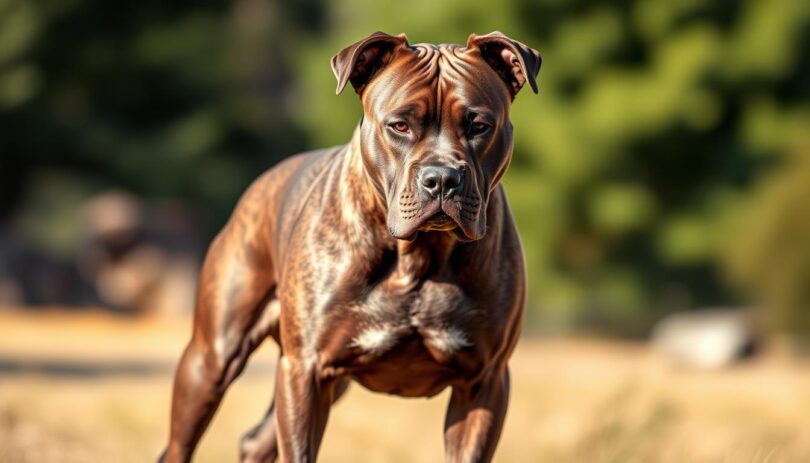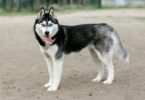Imagine coming home to a loyal companion whose eyes light up the moment you walk through the door. This is the everyday reality for many owners of the American Pit Corso—a blend of strength, intelligence, and affection. These dogs often form deep bonds with their families, offering unwavering loyalty paired with a playful spirit.
One owner shared how their pup mastered basic commands like “sit” and “stay” within weeks, showcasing the breed’s eagerness to learn. Their alert nature makes them excellent watchdogs, yet they balance this with gentle playfulness around children. Regular brushing helps manage their short, dense coat, which sheds moderately year-round.
Prospective owners should prepare for a pet that thrives on structure and companionship. Daily exercise and mental stimulation are key to keeping these energetic dogs content. Whether guarding the backyard or curling up for a nap, they adapt seamlessly to family life when properly trained.
This guide explores everything from temperament to grooming needs, helping you decide if this unique crossbreed fits your lifestyle. Discover how the American Pit Corso combines protective instincts with heartwarming devotion—a partnership built on mutual trust and respect.
Understanding the cane corso mix with a pitbull
This crossbreed merges the protective instincts of guardian dogs with the athleticism of working breeds. Historically, both parent lines served roles requiring intelligence and physical stamina. Their hybrid offspring often displays confidence and loyalty, traits that demand thoughtful handling.
High energy levels mean daily exercise is non-negotiable. Long walks, puzzle toys, or agility drills help channel their drive constructively. Without stimulation, boredom may lead to destructive chewing or digging.
Early training socialization shapes their behavior significantly. Structured routines teach boundaries while reinforcing positive interactions. Exposure to diverse environments reduces territorial tendencies, ensuring adaptability around guests or other pets.
Their natural wariness of strangers contrasts with affectionate family bonding. Obedience classes strengthen trust, allowing their protective nature to coexist with gentle play. Owners report these dogs thrive when treated as respected team members rather than subordinates.
Experienced handlers often succeed best with this breed. Consistent leadership prevents dominance issues, while patience helps manage their strong-willed streak. Proper guidance transforms raw energy into reliable companionship.
History and Breed Origins
The roots of this powerful hybrid trace back to two storied lineages shaped by centuries of selective breeding. Understanding their ancestry clarifies why these dogs exhibit such distinct physical and behavioral traits today.
American Pit Bull Terrier Background
Originally bred in 19th-century England, the American Pit Bull Terrier descended from bulldogs used in bull-baiting sports. When these practices were banned, the breed transitioned into farm work and family companionship. Their reputation as “nanny dogs” emerged from their gentle loyalty toward children.
Immigrants later brought these dogs to America, where they became symbols of resilience. Modern bull terriers retain their athleticism and intelligence, traits refined through years of responsible breeding.
Cane Corso Heritage
Ancient Roman war dogs and boar hunters form the foundation of the Cane Corso lineage. Farmers in southern Italy relied on them for property protection and managing livestock. Their name translates to “bodyguard dog,” reflecting their protective instincts.
After nearly disappearing post-World War II, dedicated enthusiasts revived the breed in the 1970s. Today’s Cane Corsos maintain their imposing stature and sharp awareness, qualities honed through generations of rigorous work.
Both breeds share a history of adaptability and purpose-driven roles. Owners today benefit from their combined strengths—vigilance from guardian roots and affection shaped by human partnership.
Physical Characteristics and Appearance
A striking blend of muscle and grace defines this hybrid’s physique. Standing 22-27 inches tall, these dogs showcase a sturdy build inherited from both parent breeds. Their broad chest and muscular legs reflect athleticism, while their square-shaped head adds to their imposing presence.
Their short coat lies close to the skin, offering low maintenance despite moderate shedding. Common colors include black, brindle, fawn, or gray, often with white markings. Weekly brushing minimizes loose hair, while occasional baths keep their coat glossy.
Skin quality varies, but some inherit slight folds around the face, requiring gentle cleaning to prevent irritation. Weight typically ranges between 70-110 pounds, comparable to Mastiffs but leaner than many large dog breeds. This size demands sturdy leashes and spacious living areas.
Compared to Boxers or Rottweilers, their frame balances power with agility. Thick necks and strong jaws highlight their guardian lineage, yet their eyes often radiate warmth. These traits mean daily exercise isn’t just optional—it’s essential for maintaining a healthy weight and temperament.
Prospective owners should anticipate a dog that commands attention without appearing bulky. Their physical needs align with active households familiar with handling strong, energetic breeds. Proper care ensures their appearance remains as impressive as their loyalty.
Temperament and Personality Traits
Owners often describe these dogs as having two distinct modes: a goofy playmate and a vigilant guardian. Their personality blends affection with an innate drive to protect, creating a dynamic companion suited for active households. Early socialization shapes how they channel their energy, ensuring they remain approachable without losing their natural alertness.
Playful but Protective Nature
Puppies typically display boundless curiosity, eagerly engaging in games like fetch or tug-of-war. As they mature over the years, their protective instincts emerge—barking at unfamiliar sounds or standing watch near windows. This transition highlights why structured training is essential to balance their playful energy with disciplined behavior.
Their love for family runs deep. Many owners report their pit bull mix leaning against them during downtime or gently nudging hands for attention. Yet, this same dog might position itself between loved ones and strangers, showcasing its dual role as both cuddle buddy and defender.
Regular socialization helps them distinguish between harmless visitors and genuine threats. Introducing them to diverse environments early reduces overprotectiveness, allowing their friendly side to shine. Consistent routines also reinforce trust, which is critical for managing their strong-willed streak.
For those considering this breed, health care tips and obedience strategies go hand in hand with nurturing their temperament. With patience, their loyalty transforms into a harmonious blend of warmth and watchfulness—a true partner for those who value devotion paired with purpose.
Energy Levels, Exercise, and Activity Requirements
Meeting this breed’s physical needs isn’t optional—it’s vital for their well-being. Their athletic lineage demands at least 60-90 minutes of structured activity daily. Without proper outlets, pent-up energy can lead to chewing, digging, or excessive barking.
Daily Exercise Routines
Start mornings with a brisk 30-minute walk or jog to burn energy. Afternoon play sessions like fetch or agility drills keep muscles engaged. Evening mental challenges, such as puzzle toys, reinforce calm behavior indoors.
Consistency matters. Schedule exercise at the same times each day to establish rhythm. Mix activities to prevent boredom—swimming, hiking, or flirt pole games work well. Always use a sturdy leash for safety during outdoor adventures.
Importance of Social Play
Dog parks or playdates provide dual benefits: physical exertion and social skills. These interactions teach bite inhibition and polite greetings. Supervised group activities also reduce territorial tendencies around unfamiliar animals.
Rotate toys weekly to maintain mental stimulation. Tug ropes and treat-dispensing balls encourage problem-solving. Pair playtime with obedience drills to reinforce commands like “drop it” or “leave it.”
Balancing physical exertion with brain games creates a happier, healthier companion. Structured routines prevent destructive habits while deepening the bond between owner and dog.
Health Considerations and Potential Issues
Maintaining your dog’s well-being starts with understanding breed-specific health risks. While these hybrids are generally robust, certain conditions require proactive care. Regular vet checkups and preventive measures can significantly enhance their quality of life.
Common Health Concerns Like Hip Dysplasia
Hip dysplasia affects nearly 20% of large-breed dogs, according to veterinary studies. This joint issue occurs when the hip socket doesn’t form properly, leading to arthritis or mobility challenges. Maintaining a healthy weight through portion control and low-impact exercises like swimming reduces strain on joints.
Other dysplasia-related issues may include elbow abnormalities. Early screening through X-rays helps identify problems before symptoms arise. Supplements like glucosamine can support joint health, especially in active dogs over age five.
Coat, Skin, and Grooming Requirements
Their short coat sheds moderately but stays manageable with weekly brushing. Use a rubber grooming mitt to remove loose hair and distribute natural oils. Bathing every 6-8 weeks prevents skin dryness, while occasional wipe-downs keep folds clean.
Skin allergies sometimes develop, causing itching or redness. Hypoallergenic shampoos and omega-3 supplements often alleviate discomfort. Trim nails monthly and check ears weekly for debris to avoid infections.
Though these dogs have low-maintenance coats, consistent grooming routines prevent minor issues from escalating. Pair care sessions with positive reinforcement to build trust and cooperation.
Training and Socialization Tips
Successful dog training blends structured lessons with positive reinforcement and daily practice. Establishing trust early helps your pet understand expectations while fostering confidence. These methods create a foundation for lifelong good behavior and adaptability.
Basic Obedience and Commands
Start with short 10-minute sessions teaching “sit” and “stay.” Use treats or praise to reward quick responses. Gradually introduce “come” in controlled environments like fenced yards before testing it in parks.
Consistency prevents confusion. Practice commands during walks or mealtimes to reinforce learning. If your dog pulls on the leash, pause until they return to your side—this teaches self-control.
Socialization should feel natural. Invite friends over weekly to expose your pet to new faces. Visit pet-friendly stores or outdoor cafes to build comfort around distractions. Always monitor interactions to ensure positive experiences.
Regular training strengthens your bond and reduces problem behaviors. Schedule sessions during low-energy periods, like after exercise, for better focus. Over time, these routines become enjoyable rituals that deepen mutual respect.
Living in the United States: Environment and Lifestyle Impacts
A dog’s environment shapes its daily rhythms just as much as its breed traits. Urban apartments and rural homesteads present unique challenges—and opportunities—for active breeds. Understanding these differences helps owners create fulfilling routines tailored to their home setting.
Urban Versus Rural Living Adaptations
City dwellers often worry about space. Dogs in apartments need structured exercise: two daily walks plus visits to dog parks for off-leash play. Stair climbing games or indoor fetch sessions compensate for limited yards. Mental stimulation becomes crucial—food puzzles prevent boredom during alone time.
Rural homes offer sprawling fields but fewer socialization chances. Owners should schedule weekly trips to town for exposure to crowds and traffic noises. Leash training remains vital near livestock or wildlife. Fenced yards allow safe exploration, though supervision prevents digging or chasing small animals.
Exercise routines adapt to both environments. Urban dogs benefit from shorter, frequent outings to avoid overstimulation. Rural companions thrive with long hikes or swimming sessions. Regardless of location, consistency in training and playtime builds confidence.
Tailoring care to your home environment ensures a happy, balanced dog. With creativity and commitment, these adaptable animals flourish wherever they live alongside their people.
Family Compatibility and Kid-Friendly Aspects
Families seeking a loyal guardian with a soft spot for playtime often discover this breed’s remarkable adaptability. Research on kid-friendly dog breeds highlights their patience with younger family members, especially when raised alongside children from puppyhood. One study notes their tendency to form protective bonds while maintaining gentle play habits.
How They Interact with Children
Parents often report their dogs displaying natural caution around toddlers—stepping carefully during games or lowering their energy levels. The Pastimes family shared how their pet gently retrieves dropped toys for their 4-year-old while monitoring backyard playdates. Early training helps reinforce boundaries, teaching pups to avoid jumping or roughhousing.
Supervised interactions build trust. Teach children to respect the dog’s space during meals or naps. Reward calm behavior with treats to associate kids with positive experiences. Many families find their pets become shadow companions, following children from room to room.
Bonding and Affection
These dogs thrive on structured routines that include every family member. Evening walks or puzzle games involving kids strengthen connections. Their affectionate nature shines during downtime, often curling up beside loved ones for movie nights.
Consistency is key. Involve children in feeding or basic command practice using guidance from reputable training resources. This teamwork builds mutual respect while channeling the dog’s protective instincts into healthy family dynamics.
With proper socialization, these loyal companions balance vigilance with tenderness. Their adaptability makes them suited for households valuing both security and heartfelt connections.
Potential Challenges for First-Time Owners
Adopting a powerful hybrid comes with unique hurdles for inexperienced handlers. High energy levels demand structured exercise routines, while their intelligence requires consistent mental challenges. Without proper guidance, these traits can overwhelm new owners unfamiliar with guardian breeds.
Common issues include destructive chewing from boredom or leash-pulling during walks. Untrained dogs might display territorial behavior around guests. Puppies often test boundaries through jumping or mouthing—behaviors that escalate without correction during their formative years.
Physical maturity brings additional considerations. Adult dogs weighing 70+ pounds need confident handling during vet visits or grooming sessions. Their protective instincts require careful shaping to prevent overreacting to normal neighborhood activities.
First-time owners should prioritize obedience classes and socialization from day one. Partnering with professional trainers helps address breed-specific behaviors early. Families must dedicate time to daily training while establishing clear household rules.
Though rewarding, raising this dog demands patience and adaptability. Building trust through routine creates a stable foundation for both pet and owner. With commitment, even novice handlers can foster a well-adjusted companion.
Grooming and Daily Care Tips
Daily care for your pet combines grooming with mindful hygiene practices. A weekly brushing routine keeps their short coat healthy while minimizing loose hair around your home. Use a rubber curry brush to massage the skin and distribute natural oils—this takes just 5 minutes but makes a lasting difference.
Bathe your companion every 6-8 weeks using oatmeal shampoo to prevent dryness. Focus on cleaning between paw pads and skin folds where dirt accumulates. Trim nails monthly to avoid cracking, and check ears weekly for redness or debris.
Manage shedding by vacuuming high-traffic areas twice weekly. Place washable blankets on furniture to catch hair. During seasonal shedding periods, use a deshedding tool every 3 days to remove undercoat buildup.
Pair grooming with exercise for balanced care. Wipe paws after walks to prevent mud trails. Store dental chews near leashes—this reinforces teeth cleaning during post-walk downtime. Consistent routines help your dog thrive for years while keeping your space fresh.
Safety and Handling: Responsible Ownership
Responsible ownership starts with recognizing the physical capabilities of your companion. These powerful dogs combine strength from their lineage with athletic agility, requiring mindful handling to ensure safety for everyone involved. Understanding their build and energy helps prevent accidents while fostering trust.
Understanding Their Strength and Size
Adult dogs in this breed often weigh 70-110 pounds, with muscular frames built for endurance. Their size demands sturdy equipment—think reinforced leashes and harnesses designed for large breeds. One owner shared how switching to a no-pull harness improved control during neighborhood walks without causing discomfort.
Secure fencing is non-negotiable. Install gates at least 6 feet tall to contain their jumping ability. Always supervise backyard play, as their enthusiasm can unintentionally knock over children or damage garden features. Training commands like “wait” at doorways prevents bolting behaviors.
Consistent reinforcement teaches polite greetings. Reward calm behavior when guests arrive, using treats to redirect excitement. Families report success with structured routines that channel energy into focused activities before social interactions.
Respect their power through proactive care. Regular vet checks monitor joint health, crucial for maintaining mobility in larger dogs. With proper guidance, these loyal pets become dependable partners rather than unpredictable forces.
Adaptability to Different Climates and Settings
A dog’s ability to thrive in diverse environments depends on both inherited traits and owner adjustments. Their short coat offers moderate insulation, but extreme temperatures require thoughtful care. Proper hydration and shelter become priorities in seasonal shifts.
Managing Hot and Cold Weather Needs
Summer heat demands shaded areas and fresh water access during yard time. Avoid midday exercise to prevent overheating—opt for early morning walks instead. In winter, limit outdoor activity during freezing temperatures and consider a waterproof coat for short-haired dogs.
Monitor weight year-round, as extra pounds strain joints in cold weather. Adjust portion sizes if activity levels drop during extreme conditions. Indoor puzzle games keep energy levels balanced when outdoor play isn’t feasible.
Traits for Home Security
Natural vigilance makes these dogs effective watchdogs. Their territorial drive pairs with keen senses to detect unusual activity. Secure your yard with 6-foot fencing to contain their protective instincts safely.
Regular training reinforces controlled responses to strangers. Channel their energy into structured patrol routines during evening walks. This balances security behaviors with mental stimulation, creating a calm yet alert household guardian.
Comparing Cane Corso Mix with Other Dog Breeds
Choosing between similar breeds requires understanding their distinct traits and lifestyle needs. While many share protective instincts or athletic builds, subtle differences determine which companion fits best in your home. Let’s explore how one popular hybrid measures up against its close relative.
American Pit Bull Terrier Versus Hybrid Companion
Size differences stand out first. Purebred American Pit Bulls typically weigh 30-60 pounds, while their mixed counterparts often reach 70-110 pounds. Both breeds need daily exercise, but the larger hybrid may require 30% more activity to stay content.
Temperament varies too. Pit Bulls often display outgoing friendliness toward strangers, whereas the mixed breed leans toward cautious observation. Training demands differ: Pit Bulls respond well to positive reinforcement alone, while hybrids benefit from structured routines that address their guardian instincts.
Energy management separates these breeds. A 60-minute walk might satisfy a Pit Bull, but the hybrid could need jogging sessions or agility drills. Families with small children often prefer the Pit Bull’s playful spontaneity, while those seeking a vigilant protector might favor the mixed breed’s alertness.
Both breeds thrive in active households but suit different lifestyles. Consider your capacity for exercise, space, and training commitment when deciding. Neither is inherently better—just uniquely equipped to meet specific needs.
Finding a Reputable Breeder or Rescue
Locating ethical sources for this rare hybrid requires diligence and research. Start by contacting breed-specific rescues focusing on guardian dogs or pit bull terrier lineages. These organizations often prioritize transparency about a dog’s health history and temperament.
When evaluating breeders, ask for proof of genetic testing and parent health screenings. Responsible breeders provide written health guarantees and invite potential owners to meet puppy parents. Avoid sellers who refuse home visits or pressure quick decisions.
Shelters occasionally receive these mixes due to their specialized needs. Visit facilities in person to assess living conditions and staff knowledge. Reputable rescues conduct behavioral assessments and offer post-adoption support to ensure successful matches.
Owners should verify credentials like AKC certifications for parent breeds. Check online reviews and ask for references from past clients. Ethical sources prioritize lifelong care over profit, often requiring adoption contracts to protect the dog’s welfare.
Patience pays off—waiting lists for well-bred puppies can span months. Meanwhile, foster programs let prospective owners trial the breed’s needs. Whether adopting or purchasing, prioritize partners committed to the animal’s lifelong well-being.
Final Thoughts on Living with This Unique Breed
Welcoming this loyal companion into your home brings both joy and responsibility. Their intelligence and protective nature shine through daily interactions, but success hinges on consistent training and socialization. Early lessons in obedience and exposure to diverse environments shape a well-rounded adult dog.
Active households thrive with these pups. Daily exercise and mental challenges prevent boredom, while routine vet visits address breed-specific health needs. Their love for family creates unshakable bonds, rewarding owners with years of companionship.
Prospective adopters must weigh the commitment. Structured routines, patience, and proper care are non-negotiable. Yet those who invest time gain a devoted partner who balances playful energy with quiet devotion.
Cherish every milestone—from mastering commands to lazy Sunday snuggles. Continue reinforcing positive behaviors as your pup matures. With understanding and effort, this remarkable dog becomes more than a pet—they become family.
FAQ
Are American Pit Corsos good family dogs?
With proper socialization, these dogs bond deeply with families. Their protective instincts and affectionate nature make them loyal companions, but supervision around young children is recommended due to their size and energy.
How much exercise does a Pit Corso need daily?
Aim for 60-90 minutes of activity like brisk walks, fetch, or agility training. Their high energy levels and working dog heritage require consistent physical and mental stimulation to prevent boredom-related behaviors.
What health issues affect this crossbreed?
Hip dysplasia, skin allergies, and bloat are common concerns. Regular vet checkups, joint supplements, and a quality diet help manage risks. Their short coat requires minimal grooming but benefits from weekly brushing.










Leave a Comment